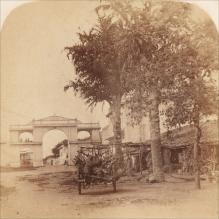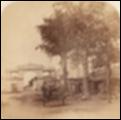| dc.coverage.spatial | Site: Hyderabad (Andhra Pradesh, India) | en_US |
| dc.coverage.temporal | creation date: ca. 1578, creation date: majority of buildings, 1810s-1840s | en_US |
| dc.creator | Bahadur, Maharaja Chandulal | en_US |
| dc.date | ca. 1578 | en_US |
| dc.date.accessioned | 2007-10-11T16:19:51Z | |
| dc.date.available | 2007-10-11T16:19:51Z | |
| dc.date.issued | 1573-1583 | en_US |
| dc.identifier | 112002 | en_US |
| dc.identifier.uri | http://hdl.handle.net/1721.3/21745 | en_US |
| dc.description | 400 stairs brings you to a place of worship built by the Asif Jahis. The Moula Ali Dargah was built in the memory of Hazrat Ali, the son-in-law of the Prophet Muhammad. Legend has it that Yakoob, a eunuch in the court of Ibrahim Quli, went to the hill after he saw Hazrat Ali seated on it. To his surprise, he saw the impression Ali's palm on a stone, which he had dreamt. He had the impression cut out and installed in a shrine. Ibrahim Shah later built a mosque beside the dargah. A Ashurkhana , a Baradari (pavilion) and an Nqqar khana (place for beating drums) were built during the Qutb Shahi period. | en_US |
| dc.description | general view, entrance gate, 1862 | en_US |
| dc.format.medium | masonry | en_US |
| dc.format.medium | stone | en_US |
| dc.relation.ispartof | 130674 | en_US |
| dc.subject | Mosques | en_US |
| dc.subject | Stairs | en_US |
| dc.subject | Hills | en_US |
| dc.subject | Shrines | en_US |
| dc.subject | Islam -- History | en_US |
| dc.subject | Complexes | en_US |
| dc.subject | Islamic cities and towns | en_US |
| dc.subject | Architecture, Islamic --India | en_US |
| dc.subject | Religious architecture | en_US |
| dc.subject | Hyderabad (India) | en_US |
| dc.subject | Gates | en_US |
| dc.subject | Entrances | en_US |
| dc.title | Koh-e Maula Ali | en_US |
| dc.title.alternative | Moula Ali Dargah | en_US |
| dc.title.alternative | Moula Ali Kaman | en_US |
| dc.type | Image | en_US |
| vra.culturalContext | Indian (South Asian) | en_US |
| vra.culturalContext | Islamic | en_US |
| vra.technique | construction | en_US |
| vra.worktype | Shrine (structure) | en_US |
| vra.worktype | Complex | en_US |
| vra.worktype | Religious building | en_US |
| dc.contributor.display | patron: naqqarkhanah gate by Maharaja Chandulal Bahadur (Indian (South Asian), 1776-1845) | en_US |


